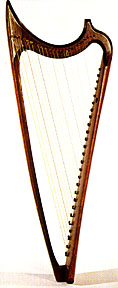The harp is an ancient instrument dating back to the Sumerian civilization. In the Middle Ages, it seems to have been strung with gut, except in Ireland where metal strings — probably brass — were used from an early date. The number of strings varied a lot, with a tendency towards increased numbers as the centuries wore on. By the l4th century there were sometimes as many as twenty-five.
Harp. Oswald von Wolkenstein: Lieder. Ensemble Sequentia. Benjamin Bagby, harp. Deutsche Harmonia Mundi 05472-77302-2 (1993). Trk 7 O snode werlt (excerpt)
Around l400 the harp acquired a more slender shape which we term “gothic,” and also a series of little elbow-shaped pegs called “bray pins” which touched the strings as they emerged from the sound-box, causing a nasal buzzing sound as the strings were plucked. This was helpful in projecting the sound, since the sound-box of the gothic harp was small (in comparison to later harps) and made of hardwood, and thus did not have the natural resonance of larger spruce-bellied instruments. It also made for a very different aesthetic from the modern harp.
Close-up of bray pins. Hell (detail) from Garden of Delights (1500-10) by Hieronymous Bosch. Madrid, Prado.
Bray-pin harp. Forse che si, forse che no: musique de danse du quattrocento. Ferrara Ensemble, dir. Crawford Young. Debra Gomez, harp. Fonti Musicali Atelier Danse fmd 182 (1989). Trk 11, Giove (excerpt).




